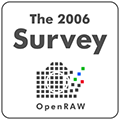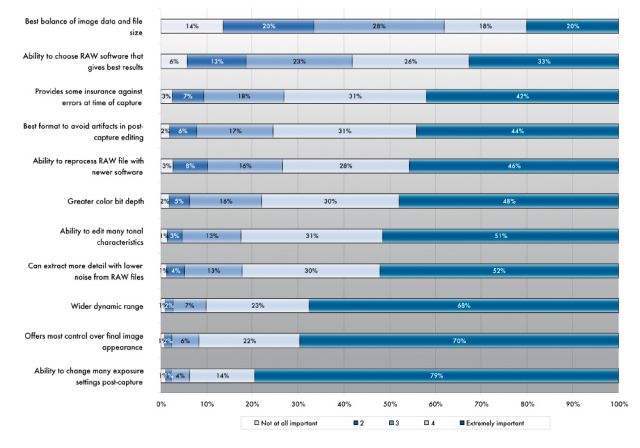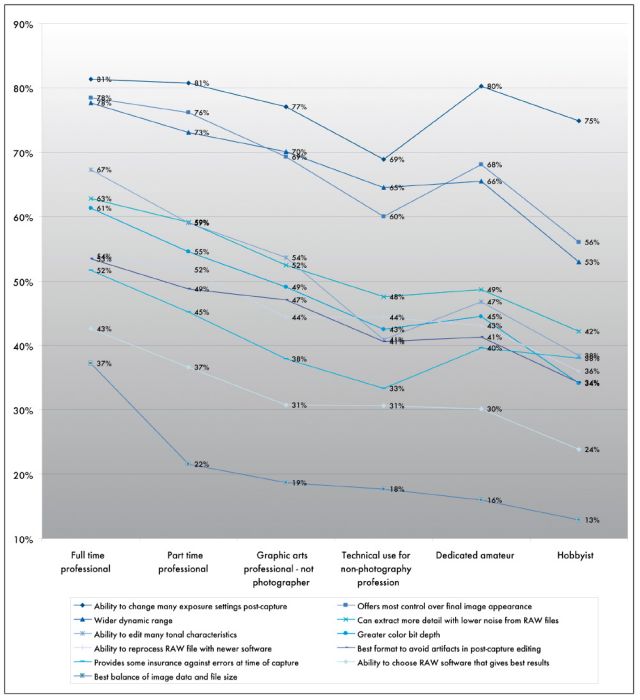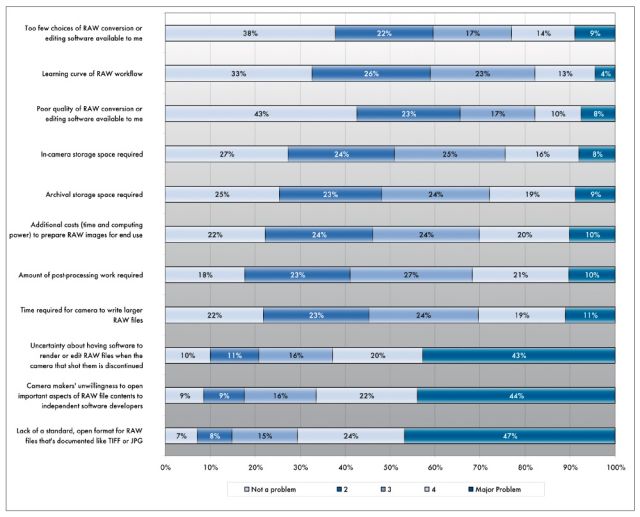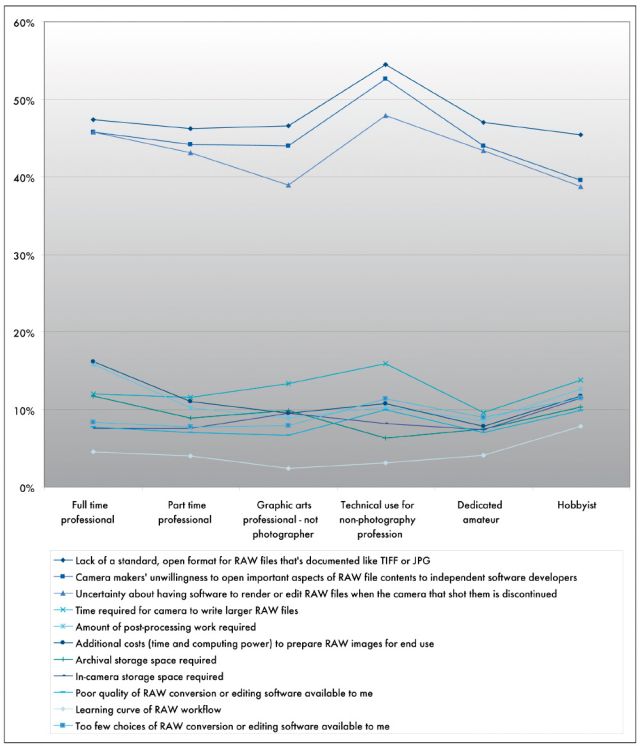The 2006 RAW Survey - Chapter 2
Chapter 2. Perceptions of the Advantages and Disadvantages of RAW Imaging Technology
The 2006 RAW Survey questionnaire included many questions that focused on the experiences, opinions, beliefs, and preferences of photographers and others who use RAW imaging technology. This chapter presents a preliminary review of the responses to these questions.
The Advantages of RAW Imaging Technology
Question #3 of the survey instrument asked: "Using a 5-point scale where "1" means "Not at all important" and "5" means "Extremely important", please rate the following potential benefits of shooting in RAW mode for your own photography." Chart 10 below shows the distributions of responses to the 11 "potential benefits" listed in this question.
Chart 10. Perceived Importance of Potential Benefits of RAW Image Files
Of the 11 potential benefits listed, all but one ("balance of image data and file size") were viewed as "very important" by at least 33% of survey respondents.
Among all potential benefits, "the ability to change many exposure settings … post capture" was the factor that most respondents (79%) considered to be "extremely important." In fact, 93% of respondents ranked this item with values "5" (extremely important) or "4."
Next in priority, 68% to 70% of survey respondents indicated that "wider dynamic range" and "offers most control over final image appearance" to be "extremely important." Over 90% of respondents chose response categories "4" or "5" (extremely important") for these two items.
The ability "to extract more detail with lower noise" and "to edit many tonal characteristics" were considered "extremely important" by more than 50% of respondents, and to be "important" (given ratings of "4" or "5" by over 80% of respondents.
Four of the "potential benefits" listed were ranked as "extremely important" by between 40% and 50% of respondents (between 70% and 80% rated these items as "4" or "5"). These items included, "greater color bit depth," "ability to reprocess RAW files with newer software," "best format to avoid artifacts in post-capture editing," and "insurance against errors at time of capture."
Significantly, the item "ability to choose RAW software that gives the best results" was considered an "extremely important" benefit by only 33% of respondents (compared to 79% who gave the same high rating to "ability to change many exposure settings post-capture"). This indicates to us that while the ability to change some exposure settings is considered an exceptionally important property of RAW technology, the ability to choose RAW software to change those exposure settings is not seen as an important advantage by many respondents. One interpretation of this finding is that photographers see the potential of changing exposure settings as extremely important, but that the current RAW technology implementation – including the differences in rendering that result from different software packages - creates obstacles to choosing and using RAW software, thus making the most important benefit of RAW technology less available than photographers would prefer. We present more survey results on this question in the following sections.
Finally, providing the "best balance of image data and file size" was viewed as a "very important" advantage by only 20% of survey respondents. We may conclude from these responses that, compared to factors related to image quality, the potential logistic benefits associated with RAW image formats (e.g., reduced storage requirements compared to, say, uncompressed TIFF files) is not a feature of RAW image technology that most respondents believe is the key benefit of shooting in RAW mode.
Chart 11 below displays the percentage of each of the six categories of photographer/imaging specialists that rated each of the eleven potential benefits of shooting in RAW mode as "extremely important." The chart shows that the percentage that rate "ability to change most exposure settings" as "extremely important" varies from about 81% of professional photographers down to 69% of "technical users," and to 75-80% of amateurs/hobbyists. Despite these differences, all six categories of photographers/image users rate this potential benefit higher than the next two potential benefits (control over final image appearance and wider dynamic range). In turn, these two potential benefits are both rated higher by all six categories of photographer/image specialist than the next six potential benefits. Further, these six factors are considered by all six photography categories to be more important than "ability to choose RAW software that gives best results," which is, in turn, considered more important by all categories to be more important than the "balance of image data vs. file size."
Although there is variation across types of photographers in the percentages who consider each potential benefit levels to be "extremely important," the eleven potential benefits of shooting in RAW mode are given roughly the same "rank order" by all photographers, regardless of their professional or amateur status.
Chart 11. Percentage of Respondents in Six Photography User Categories that Rate each of 11 Potential Benefits of RAW Images as "Very Important"
Disadvantages of Shooting RAW
Question 4 in the survey asked: "Using a 5-point scale where "1" means "Not a problem," and "5" means "Major problem," please rate the following potential disadvantages of shooting in RAW mode for your own photography." Chart 12 below displays the percentages who chose each "problem level" for each of the 11 potential disadvantages.
Chart 12. Ratings of Eleven Potential Disadvantages of RAW Image Technology
Eight of the 11 potential disadvantages listed were rated as a "major problem" by less than 12% of the respondents (the first eight factors listed in Chart 9 above). Moreover, less than 1/3 of survey respondents gave these eight factors rating scores of "4" or "major problem."
Between 59% and 66% of respondents ranked three of the listed "potential disadvantages" as either "not a problem" or "2" on the five-point scale – "Too few choices of RAW conversion or editing software available to me," "Learning curve of RAW workflow," and "Poor quality of RAW conversion or editing software available to me."
Between 41% and 51% of respondents gave "Not a problem" or "2" ratings to the next five factors, including "In-camera" and "archival" storage space required, "Additional costs (time and computing power) to prepare RAW images for end use," "Amount of post-processing work required," and "Time required for camera to write larger RAW files."
Conversely, three of the eleven potential disadvantages were rated as "major problems" by more than 40% of respondents – "Uncertainty about having software to render or edit RAW files when the camera that shot them is discontinued" (43%), "Camera makers’ unwillingness to open important aspects of RAW file contents to independent software developers" (44%), and "Lack of a standard, open format for RAW files that’s documented like TIFF or JPG" (47%). Each of these three items was given a score of "4" or "Major Problem" by between 63% and 71% of survey respondents. It is clear from these patterns that the majority of respondents consider the main disadvantages of using RAW image technology to arise from their concerns about the risks inherent in proprietary RAW file formats.
Chart 13 displays the percentage of respondents who rated each of the 11 potential disadvantages as a "Major problem" for each of the six categories of photographer or imaging specialist.
Chart 13. Percentage That Rate Eleven Potential Disadvantages of Shooting RAW as a "Major Problem" by Categories of Photography Users
Chart 13 makes clear that there are few differences across categories of photographers or imaging specialists in the degree to which they ranked each of the 11 potential disadvantages of shooting RAW as a "Major Problem." Much larger percentages of all six categories rate the three factors related to proprietary RAW file formats as a "major problem" compared to the other eight factors related to either logistical matters (storage, time consumed, etc.) or the greater time or technical demands of a RAW workflow.

